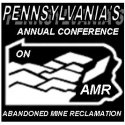Treatment Systems created to treat Abandoned Mine Discharges. The basic concept of a treatment system is to remove metals (which are often invisible when dissolved in solution) and raise pH of the water (if net acidic). There are many ways that this can be accomplished> Systems that require round the clock maintenance and addition of chemicals are typically referred to as “active” treatment systems. “Passive” treatment systems often cost more initially to install (compared to active treatment), but are designed to passively treat the water for 10 to 15 years, with minimal maintenance, before replacement. There are a multitude of types, shapes and sizes of passive treatment systems based on the chemistry and size of discharge they are treating. Below are only a few of the different types of treatment systems found in the Anthracite Region of Pennsylvania.
Aerobic Wetlands, Espy Run Phase 1 PTS in the Nanticoke Creek Watershed, Luzerne County, PA


Oxic Limestone Drain, Oneida 1 PTS in the Catawissa Creek Watershed, Schuylkill County, PA


Above is a shot of the Catawissa Creek Restoration Association’s Anoxic Limestone Drain Passive Treatment System that treats the Oneida #1 Discharge in the Catawissa Creek Watershed. The shot to the left was taken at the bottom of the settling pond looking up toward the source of discharge in the top left hand corner of the picture. The shot above to the right is a photo during construction of the system showing the limestone beds that were constructed to convey the water. The acidic aluminum laden water filters through 8,000 tons of limestone that lies underneath the large field in the center of the picture. The treated water is then conveyed via limestone rock channels into the settling pond where the aluminum is collected giving it a greyish/white appearance. The clean water is then distilled off the top and flows back into the Sugarloaf Creek. The system is periodically flushed into the settling pond and requires a bit more routine maintenance than the system above to clean out accumulated metals and debris.
Vertical Flow Wetland, Gutten Drift (Bernice) PTS in the Loyalsock Creek Watershed, Sullivan County, PA



Here in Pennsylvania community groups, environmental “Good Samaritans” and the state/federal government have been working collectively to advance the science of passive treatment. Some innovative technologies have “filtered out” in the process. The Trompe Aerator is one of those innovative technologies. This 16th century idea uses falling water to create air pressure, which can be used generate bubbles in water there by dropping dissolved metals out of solution. Oxygen is often a limiting factor in iron dissolution in passive treatment systems. With the addition of an aerator, the iron will drop out more readily and reduce the surface area needed to settle out metals by a factor of 10.
EPCAMR helps to update an online database of AMD Treatment Systems in PA called Datashed.org. We attempt to keep track of and add new treatment systems to the database so that they may be considered for current and future Operation and Maintenance Funding. If your treatment system is not in the database, please email hardcoal@epcamr.org or sign up for an account on Datashed.org to add and maintain it yourself.
Want to see More Pictures of PTS? Go to the Passive Treatment System Section of our Photo Gallery












You must be logged in to post a comment.